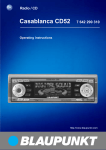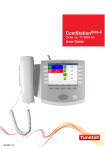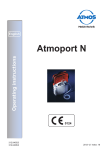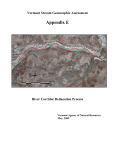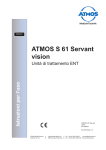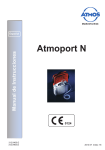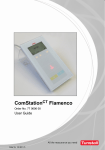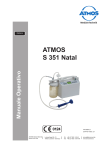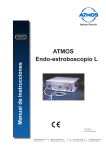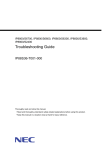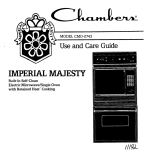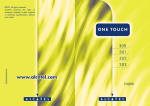Download Operating Instructions
Transcript
CONCENTOPLUS Operating Instructions COMMUNICATION IN PERFECTION For nursing homes and assisted living – Safety in accordance with DIN VDE 0834 Part 1 & 2 1 This manual was compiled with great care and all the information it contains has been checked for correctness. However, no liability can be accepted for incorrect or incomplete information. All rights reserved, particularly those relating to copy‐ ing and dissemination. No part of the documentation may be reproduced or elec‐ tronically processed, copied or disseminated without the prior written permission of Tunstall GmbH. We reserve the right to make technical changes. We reserve the right to make content change E Tunstall GmbH CONCENTOPLUS S Operating Instructions S 00 8814 16 S 11/12 (Rev. 2.0) 2 1. Contents 2. Safety . . . . . . . . . . . . . . . . . . . . . . . . . . . . . . 5 2.1 2.2 General safety instructions . . . . . . . . . . . . . . . . . . . . . . . . . ”Fault”, ”FLT” or ”FR” appears? . . . . . . . . . . . . . . . . . . . . . 5 5 3. Necessary basic knowledge . . . . . . . . . . 6 3.1 3.2 3.3 3.4 3.5 3.6 3.7 3.8 3.9 Sequence of handling a call . . . . . . . . . . . . . . . . . . . . . . . . Presence registration . . . . . . . . . . . . . . . . . . . . . . . . . . . . . . Call categories and call types . . . . . . . . . . . . . . . . . . . . . . Call display . . . . . . . . . . . . . . . . . . . . . . . . . . . . . . . . . . . . . . Abbreviations used in displays . . . . . . . . . . . . . . . . . . . . . . Timezones . . . . . . . . . . . . . . . . . . . . . . . . . . . . . . . . . . . . . . . Telephone for answering a call . . . . . . . . . . . . . . . . . . . . . Call forwarding to a Telecare Control Centre . . . . . . . . . . Call display on pagers or DECT telephones . . . . . . . . . . 6 6 8 9 9 9 10 10 10 4. Room lamp . . . . . . . . . . . . . . . . . . . . . . . . . 11 5. Corridor display . . . . . . . . . . . . . . . . . . . . . 12 6. Pear push switch & connection socket 7. Call switches . . . . . . . . . . . . . . . . . . . . . . . . 14 8. Cancel switch/WC . . . . . . . . . . . . . . . . . . . 15 9. Room terminals - Introduction . . . . . . . . 16 13 10. Terminal SD6 P . . . . . . . . . . . . . . . . . . . . . . 17 10.1 10.2 10.3 10.4 10.5 10.6 10.7 Staff presence registration . . . . . . . . . . . . . . . . . . . . . . . . . Displaying calls . . . . . . . . . . . . . . . . . . . . . . . . . . . . . . . . . . . Handling a call . . . . . . . . . . . . . . . . . . . . . . . . . . . . . . . . . . . Attending to a person seeking help . . . . . . . . . . . . . . . . . . Calling for assistance . . . . . . . . . . . . . . . . . . . . . . . . . . . . . Speaking to staff . . . . . . . . . . . . . . . . . . . . . . . . . . . . . . . . . . Announcement . . . . . . . . . . . . . . . . . . . . . . . . . . . . . . . . . . . 18 19 19 21 21 22 23 3 10.8 10.9 Switching timezone manually . . . . . . . . . . . . . . . . . . . . . . . Setting timezone for one terminal only . . . . . . . . . . . . . . . 26 27 11. Terminal S4 P . . . . . . . . . . . . . . . . . . . . . . . 29 11.1 11.2 11.3 11.4 11.5 Staff presence registration . . . . . . . . . . . . . . . . . . . . . . . . . Displaying calls . . . . . . . . . . . . . . . . . . . . . . . . . . . . . . . . . . . Handling a call . . . . . . . . . . . . . . . . . . . . . . . . . . . . . . . . . . . Attending to a person seeking help . . . . . . . . . . . . . . . . . . Calling for assistance . . . . . . . . . . . . . . . . . . . . . . . . . . . . . 30 30 30 31 32 12. Terminal S4 B . . . . . . . . . . . . . . . . . . . . . . . 33 12.1 Staff presence registration . . . . . . . . . . . . . . . . . . . . . . . . . 12.2 Displaying calls . . . . . . . . . . . . . . . . . . . . . . . . . . . . . . . . . . . 12.3 Handling a call . . . . . . . . . . . . . . . . . . . . . . . . . . . . . . . . . . . 12.4 Attending to a person seeking help . . . . . . . . . . . . . . . . . . 12.5 Calling for assistance . . . . . . . . . . . . . . . . . . . . . . . . . . . . . 12.6 Inactivity alarm function . . . . . . . . . . . . . . . . . . . . . . . . . . . . 34 34 34 35 36 36 13. Display module . . . . . . . . . . . . . . . . . . . . . . 38 13.1 Staff presence registration . . . . . . . . . . . . . . . . . . . . . . . . . 13.2 Displaying calls . . . . . . . . . . . . . . . . . . . . . . . . . . . . . . . . . . . 13.3 Attending to a person seeking help . . . . . . . . . . . . . . . . . . 13.4 Calling for assistance . . . . . . . . . . . . . . . . . . . . . . . . . . . . . 38 39 39 40 14. Call / presence combination bus . . . . . . 41 14.1 Staff presence registration . . . . . . . . . . . . . . . . . . . . . . . . . 14.2 Displaying calls . . . . . . . . . . . . . . . . . . . . . . . . . . . . . . . . . . . 14.3 Attending to a person seeking help . . . . . . . . . . . . . . . . . . 14.4 Calling for assistance . . . . . . . . . . . . . . . . . . . . . . . . . . . . . 41 41 42 42 15. Handling a call on the telephone . . . . . . 43 15.1 Answering a phone call . . . . . . . . . . . . . . . . . . . . . . . . . . . . 15.2 Handling a call . . . . . . . . . . . . . . . . . . . . . . . . . . . . . . . . . . . 15.3 Commands during the speech connection . . . . . . . . . . . . 15.4 Deny a call . . . . . . . . . . . . . . . . . . . . . . . . . . . . . . . . . . . . . . 43 43 45 45 16. Cleaning and disinfection . . . . . . . . . . . . 46 16.1 16.2 4 Cleaning and disinfection . . . . . . . . . . . . . . . . . . . . . . . . . . Device materials . . . . . . . . . . . . . . . . . . . . . . . . . . . . . . . . . . 46 47 2. Safety 2.1 General safety instructions Warning! Please follow the safety instructions below: 2.2 n You must acquire sufficient knowledge about operating and using the nurse call system via suitable measures such as training ses‐ sions. The measures must be repeated if necessary. These operat‐ ing instructions assume that the reader possesses sufficient know‐ ledge. n These operating instructions assume that you are familiar with the nursing procedures in your institution. n Third-party devices and equipment (e.g. monitoring device for dia‐ gnostic call) may only be connected by persons who have received special training to do so. n Report all function irregularities, failures and faults to a technician immediately. n Instruct residents/patients on how to operate the call devices. n Test the plug-in call devices (pear push switch etc.) after every plug-in procedure to ensure perfect functioning of call triggering. n Do not expose the devices to any extreme conditions such as great heat or cold, wet, a lot of dust or heavy vibrations. ”Fault”, ”FLT” or ”FR” appears If ”Fault”, ”FLT” or ”FR” is shown on a display of the nurse call system, you must act immediately. There is a fault in the nurse call system, which means that it is possible that not all calls will be displayed. l Note everything that is shown in the display and notify a respons‐ ible technician of this immediately. ¢ The technician will make sure that the fault is remedied. Note! Additional information about the type of fault is provided by the call documentation in the ConLogPLUS Management Software. 5 3. Necessary basic knowledge 3.1 Sequence of handling a call 3.1.1 1. Raising a call A resident/patient presses a call switch when he or she needs help. The call is displayed on the room lamp of the call location, on the cor‐ ridor display and on the room terminals rooms, where staff is present. 3.1.1.1 2. Answering a call with speech possibility If a room terminal with speech possibility is installed at the call location and in the room, where staff is present, the staff answer the call, i.e. make a speech connection to the call location. The staff ask what as‐ sistance the resident/patient requires. 3.1.1.2 3. Attending to a person seeking help The staff member goes to the call location in order to attend to the resident/patient. When entering the room, the staff member activates the presence button. 3.1.1.3 4. Cancelling the call The call must be cancelled once the patient has been attended to. In most cases, the call is cancelled automatically when the staff member activates or deactivates the presence button at the call location. Calls from WC rooms must be cancelled by pressing a WC cancel but‐ ton in the WC room. Some call types (bed call, room call, inactivity alarm) can be remotely cancelled when the call is answered. Staff do not have to go to the call location. 3.2 Staff presence registration One important prerequisite for proper use of the nurse call system is registration of presence in the rooms. 6 A distinction is made between two groups of staff: n Staff 1: e.g. nursing staff (green presence button) n Staff 2: e.g. doctors (yellow presence button) Note! Presence 2 (yellow) is only available when the Terminal SD6 P is installed in the room. Activated Presence: n Signals the presence of staff in the room. n Prepares the display of calls. n Prepares the initiation of an emergency call. This means that calls from rooms with activated presence are signalled with higher prior‐ ity. n Calls in the room are cancelled by the activation or later deactiva‐ tion of presence (exception: calls in the WC). 7 3.3 Call categories and call types Call category Call type Calls (low priority) Bed call A call button on the bed (e.g. pear push switch) was pressed or the plug of a plug-in call device (e.g. pear push switch) was pulled out of the socket. Room call A call button in the room (e.g. at the room terminal) was pressed. Inactivity alarm Patient/resident was not active for longer than 25 hours (inactivity alarm func‐ tion, see Page 36ff). WC call A call button was pressed in the WC room. Emergency Emergency call 1 calls (medium prior‐ Emergency call 2 ity) Alarm calls (highest prior‐ ity) A room call was raised with Presence 1 activated. A room call was raised with Presence 2 activated (only possible on Terminal SD6 P) Bed emergency call A bed call was raised with Presence activated. Emergency call WC A WC call was raised with Presence activated Cardiac alarm A special key combination on Terminal SD6 P was pressed or a special call de‐ vice was pressed in order to summon specialist staff (e.g. resuscitation team). In addition, a large selection of other call types can be used in the nurse call system. Examples: 8 n Fire alarm: Smoke detector signals the presence of smoke n Diagnostic alarm: A medical monitoring device has raised a call. n Telephone call: Automatically raised call when the telephone rings in a staff room while Presence is deactivated. 3.4 Call display When a call is raised, it is indicated by the room lamp of the call location and on the ward's corridor display. It is also signalled on the room ter‐ minals in the rooms of the ward in which staff presence is activated. Alarm calls and the fire alarms are displayed in all of the facility's wards. The following occurs when the nurse call system is set accordingly: If a call is not answered within a certain time (between 1 and 15 minutes, depending on the setting), it is automatically forwarded to all of the fa‐ cility's wards for displaying. 3.5 3.6 Abbreviations used in displays Call type 8-digit corridor dis‐ play 16-digit corridor display, Terminal SD6 P, display mo‐ dule Staff presence 1 ST1 STAFF1 Staff presence 2 ST2 STAFF2 Bed call B-1 ... 4 BED 1 ... 4 Room call RM ROOM Inactivity alarm INA INACTI WC call WC WC Emergency call 1 E1 EMER 1 Emergency call 2 E2 EMER 2 Bed emergency call EB1 ... 4 EMER B1 ... B4 Emergency call WC EWC EME WC Cardiac alarm ALM ALARM Fault FR FLT Timezones The nurse call system adapts itself to the institution's shift system. The staff's area of responsibility often changes in the various shifts. 9 Whereas the staff is responsible for one ward during the day for ex‐ ample, the night shift is often responsible for the entire facility. The nurse call system is organised so that all calls of the staff's respect‐ ive area of responsibility are displayed. Organisation is based on timezones. The system administrator can set up as many as 9 different timezones per nurse call system. The staff's area of responsibility for this time is stored for each timezone. Depending on the nurse call system setting, the timezones are either changed automatically or the staff change the timezones manually on a special Terminal SD6 P (see Page 26). 3.7 Telephone for answering a call The nurse call system can be set so that the calls can also be answered on the telephone. When a call is made in the nurse call system, a tele‐ phone is called parallel to the display within the nurse call system. The staff answer the call. A synthetic voice announcement informs them of the call. A speech connection to the call location is established if pos‐ sible. The staff can establish on the phone what assistance is needed. Certain call types can be cancelled remotely. 3.8 Call forwarding to a Telecare Control Centre The nurse call system can be set so that the calls are forwarded to a Telecare Control Centre at certain times (e.g. at night or at the week‐ end). The staff there handle the call initially, and then organise the ne‐ cessary measures. 3.9 Call display on pagers or DECT telephones The nurse call system can be set so that calls can be displayed on pagers or in the display of DECT telephones. 10 4. Room lamp Room lamps show the calls in the corridor, along with presence in the associated room: Red: Call Green: Presence White: Call location = WC Room lamp Room lamp with doorplate The green light section is on when Presence is activated. The red light section flashes or is on when a call has been raised. The flashing sequence of the red light section depends on the category of the call: Call category Red light section Calls continuous light Emergency calls flashes (1 sec. / 1 sec.). Alarm calls flashes quickly (0.3 sec. / 0.3 sec.) The white light section is on when the call has been raised in the WC, i.e. in the event of a WC call or an Emergency call WC. 11 5. Corridor display The oldest call of the highest priority is displayed on the corridor dis‐ plays. Presences are displayed if there is no call. If there is no presence, any faults in the nurse call system are dis‐ played. If there is no message, the time is displayed. Call type (Abbreviation) Call location, e.g. room no. B−1 R104 Corridor display, 8-digit Call type (Abbreviation) BED 1 Call location, e.g. room type + room no. Res. R104 Corridor display, 16-digit See Page 9 for the meanings of the abbreviations in the corridor dis‐ plays. 12 6. Pear push switch & connection socket There is normally a connection socket on the resident's / patient's bed to which a pear push switch is connected to raise a call. 1 1 2 Pear push switch incl. call & light switch 1 2 1 1 1 Pear push switch incl. call switch 3 Pear push switch incl. call & light switch 1 Pear push switch incl. 2 call switches 4 3 3 Call switch with 1 connection socket Call switch with 2 connection sockets Self-releasing adapter for pear push switch 1 Red call button for raising a call. - Glows dimly so that the button can be found in the dark. - Lights up or flashes brightly when a call has been raised. 2 Yellow light switch for switching the light on and off. 3 Socket For pear push switch or another plug-in call device 4 Self-releasing adapter Between socket and pear push switch. Automatically discon‐ nects the cable connection under tensile stress and thereby pro‐ tects against damage. Warning! Check plug-in call devices (pear push switches etc.) after every plugging in to ensure that raising calls is working perfectly. 13 7. Call switches All red buttons in the nurse call system are for raising calls. 1 Call switch 1 3 2 Pull cord switch Pneumatic call switch Large-surface pneumatic switch 1 Red call button for raising a call by pressing the button. - Glows dimly so that the button can be found in the dark. - Lights up or flashes brightly when a call has been raised. 2 Red call cord for raising a call by pulling. 3 Red call ball for raising a call by pressing the ball. Note! The air hose of the pneumatic switch must be pushed as far as possible onto the metal nozzle. Otherwise, it may not be possible to raise a call with the call ball. If the air hose is not on the stop, a call is automatically raised so that the staff is informed about this situation. You cannot cancel the call until the air hose is pushed onto the nozzle as far as possible. Note! Different call devices for special applications, e.g. radio call de‐ vice, can also be connected to the nurse call system. Inform yourself about the respective call device in the operating instructions enclosed with the device. 14 8. Cancel switch/WC Calls raised in the WC room, i.e. WC calls and Emergency calls WC, must be cancelled on location by pressing a WC cancel button. A can‐ cel switch/WC or a call & cancel switch/WC can be installed for this. The call & cancel switch/WC also has a call button for raising a call. 1 2 1 Cancel switch/WC Call & cancel switch/WC 1 Grey WC cancel button for cancelling a WC call or Emergency call WC. - Lights up brightly when a WC call or an Emergency call WC has been raised. 2 Red call button for raising a call. - Glows dimly so that the button can be found in the dark. - Lights up or flashes brightly when a WC call or an Emergency call WC has been raised. 15 9. Room terminals - Introduction A room terminal is installed in the entrance area of every room. Terminal SD6 P Display module Terminal S4 P Terminal S4 B Call/presence combination bus All room terminals have presence buttons with which the staff activate and deactivate their presence. When Presence is activated, the calls of the area of responsibility (one or more wards) are displayed on the room terminal. A call tone sounds. The tone sequence depends on the call category (see Page 8) of the call. Call category Call tone Calls 1 sec. tone – 10 sec. pause Emergency calls 1 sec. tone – 1 sec. pause Alarm calls 0.3 sec. tone – 0.3 sec. tone The calls are also shown in the display on Terminal SD6 P and on the display module. Here, the same abbreviation is used for the call type as is used in the 16-digit corridor display, see Page 9. The room terminals will be introduced individually in the following chapters. 16 10. Terminal SD6 P Microphone Display Loudspeaker Optional pull cord for raising a call. Red call button - LED faintly illuminated for finding the button in the dark. - LED illuminated or flashes brightly when a call has been raised. Green presence button staff 1 - LED is on when presence 1 is activated. Answer button (grey) - LED is on when there is a speech connection to a call location. Remote cancel button (grey) Universal button (grey) - The function of the button depends on how it has been set, e.g. as a WC cancel button for calls in the WC. Consult your system administrator. - If the universal button is set up as a WC cancel button, the LED is on when a WC call or an Emergency call WC has been raised. Yellow presence button staff 2 - LED is on when presence 2 is activated 17 If there is no message, the display shows the active timezone (see Page 9) and the time. CONCENTO 3 12:04 Timezone Time 10.1 Staff presence registration 10.1.1 When entering the room l Switch on the green presence button (Staff 1) or the yellow pres‐ ence button (Staff 2). ¢ The LED in the presence button comes on. 10.1.1.1 When leaving the room l Switch off the green presence button (Staff 1) or the yellow pres‐ ence button (Staff 2). ¢ The LED in the presence button is dark. 18 10.2 Displaying calls If presence is activated at the terminal, the calls of your area of respons‐ ibility (one or more wards) are indicated - in the display and via a call tone (see Page 16). Your own room's calls are shown only in the dis‐ play. Call type Number of other messages (see Page 12) in the background BED 1 3 R104 MAY Call location, e.g. room no. + room type (more than 8 characters as ticker-type text) The oldest call of the highest priority is displayed if there are several calls. The number of all other calls, presence registrations and any nurse call system faults is displayed at the top right. l 10.3 You can scroll through all messages by pressing the remote cancel button several times. Handling a call This is how to handle the call that is currently displayed. l Press the answer button. ¢ If there is a speech possibility to the call location, a speech connec‐ tion to the call location is established. The call is answered. Read more in the section ”Call with speech possibility”. ¢ If there is no speech possibility to the call location, a warning tone sounds and ”not possible” appears in the display. Read more in the section ”Call without speech possibility”. 19 10.3.1 Call with speech possibility By pressing the answer button, you have established a speech con‐ nection to the call location: l Speak to the person seeking help and ask him or her what sort of help he or she needs. The speech time is limited (depending on the setting: between 1 and 10 min.). l To end the talk and park the call, press the answer button again 1). ¢ The speech connection is closed. The call is parked. l Deactivate Presence when you leave the room. Go to the call location and attend to the person seeking help, see chapter 10.4. Note! Parked calls continue to be shown in the displays. If a parked call is not cancelled within a certain time (depending on the setting: between 1 and 30 minutes), it is automatically signalled again audibly. 10.3.1.1 1) Cancel bed call, room call or inactivity alarm You can cancel a bed call, room call or inactivity alarm remotely. This is appropriate if you were already able to assist the person seeking help during the call, and therefore don't need to go to the call location. l Press the remote cancel button instead of the answer button. ¢ The speech connection is closed. The call is cancelled. Handling of the call has been completed. 10.3.2 Call without speech possibility If ”not possible” appears in the display after the answer button has been pressed and a warning tone sounds, you cannot make a speech con‐ nection to the call location. l 20 Go to the call location and attend to the person seeking help, see chapter 10.4. In the following cases, you cannot make a speech connection to the call location: 10.4 n No speech device at the call location. This means the room ter‐ minal is a call/presence combination bus (RAB) or display module. n Call was raised in the WC (WC call, Emergency call WC). n The speech line is engaged. Attending to a person seeking help Your help is needed in another room: 10.5 l Checking out of the current room: Deactivate Presence. l Go to the call location. l Checking in at the call location: Activate Presence. l Attend to the person seeking help. Call for assistance if necessary, see Chapter 10.5. l If the call was raised in the WC, press the grey WC cancel button in the WC or (if the universal button is set as the WC cancel button), press the universal button on the terminal in order to cancel the call. Note: All other call types are automatically cancelled when Pres‐ ence is activated or deactivated. l Deactivate Presence. Calling for assistance 10.5.1 Raising an emergency call You are in the room, have activated your Presence and need assist‐ ance: l Press the red call button on the terminal or pull the pull cord on the terminal or press another call button in the room. ¢ An emergency call is raised with Presence activated. The pressed call button flashes brightly (1 sec. on / 1 sec. off). 21 10.5.2 Raising an alarm call You are in the room, have activated your Presence and need assist‐ ance with the highest priority (e.g. resuscitation team): l Keep the universal button pressed while also pressing the red call button. Release the universal button first, then the red call button. + ¢ The LED in the call switch is bright and flashes quickly (0.3 sec. on / 0.3 sec off). 10.6 Speaking to staff You can speak to staff who have activated their presence in a room via the Terminal SD6 P. Proceed as follows: l With the remote cancel button, scroll through the messages on the display until the presence message of the staff member you want to talk to is displayed. STAFF1 3 R103 Sch l Press the answer button. ¢ A speech connection to the staff member's location is established. l Speak to the staff member. You hear the staff member's reply. The speech time is limited (depending on the setting: between 1 and 10 min.). l Press the answer button again to close the speech connection. ¢ The speech connection is closed. 22 10.7 Announcement Function available only at Terminal SD6 P in the staff room when pres‐ ence is activated at the terminal. At Terminal SD6 P with the ”staff room” setting you can make an‐ nouncements that are transferred to the other terminals. You can select the following announcement destinations: Announcement type Announcement destination SP AW1 LGR xxx1) All rooms of your ward and wards coupled to your ward, where Presence 1 is activated. SP AW2 LGR xxx1) All rooms of your ward and wards coupled to your ward, where Presence 2 is activated. SP AW1+2 LGR xxx1) All rooms of your ward and wards coupled to your ward, where Presence 1 or Presence 2 is activated. SP ALL LGR xxx1) All rooms of your ward and wards coupled to your ward. SP ALL LGR Sel. All rooms of a selected other ward 1) LGR = Logic group = Ward, xxx = Ward number Note! All currently active speech connections are interrupted during an announcement. 10.7.1 Announcements to your ward and wards coupled to your ward l Keep the answer button pressed for 5 seconds. ¢ The display shows: SP AW1 LGR xxx 23 l Scroll through the available announcements with the red call but‐ ton. Press it as often as necessary until the desired announcement type appears. (Note: To abort, press the green presence button.) l Press the remote cancel button to start the announcement. ¢ The announcement is started. Your voice is transmitted after two start tones. The announcement is started with announcement tones at the terminals that convey the announcement. l Make the announcement. The speech time is limited (depending on the setting: between 1 and 10 min.). l Press the answer button to end the announcement. ¢ The announcement menu is closed. The announcement proced‐ ure is ended. 10.7.2 Announcement to a selected other ward l Keep the answer button pressed for 5 seconds. ¢ The display shows: SP AW1 LGR xxx l Press the red call button as often as necessary until the following display appears: SP All LGR Sel. l Press the remote cancel button. ¢ The display shows: ”LGR001”. 24 l Scroll with the red call button as far as the desired ward number. (Note: To abort, press the green presence button.) l Press the remote cancel button to start the announcement. ¢ The announcement is started. Your voice is transmitted after two start tones. The announcement is started with announcement tones at the terminals that convey the announcement. l Make the announcement. The speech time is limited (depending on the setting: between 1 and 10 min.). l Press the answer button to end the announcement. ¢ The announcement is ended. The display shows: SP All LGR Sel. l If you want to make an announcement to another ward, use the red call button to scroll as far as the desired ward and proceed as de‐ scribed above. l Press the green presence button in order to close the announce‐ ment menu. ¢ The announcement menu is closed. The announcement proced‐ ure is ended. 25 10.8 Switching timezone manually This function is only available if the timezones are not automatically switched over in the nurse call system. The function is only available at one Terminal SD6 P in the building (setting ”Staff room with HAB”). Consult your system administrator. The system administrator will tell you which timezones are available to you. This is how to switch the active timezone, for example for a shift change: l Keep the yellow presence button pressed for 5 seconds. ¢ The active timezone is shown in the display: T−Zone 1 DAY l Scroll through the available zones with the red call button. Press it as often as necessary until the desired zone type appears. (Note: To abort, press the green presence button.) l To switch to the displayed zone, press the remote cancel button ¢ The menu is closed. The selected timezone is activated. The num‐ ber of the activated, i.e. active, timezone is shown in the display of all terminals SD6 P if there are no messages. Note! If you press no button for longer than 1 minute, the menu is auto‐ matically exited without switching the timezone. 26 10.9 Setting timezone for one terminal only The function is available on all terminals SD6 P with the ”Staff room” setting. Consult your system administrator. For your Terminal SD6 P you can set a different timezone to the one set in the nurse call system. Here you can set all timezones (timezone 1–9) that are prepared in your nurse call system. Consult your system administrator. You can also set the timezone A ”All calls”. If you set the timezone A, all messages of the nurse call system (calls, presences, fault mes‐ sages) are displayed on your terminal. The timezone setting for a terminal is temporary. It is cancelled when the timezone of the nurse call system is switched. Exception: The timezone A ”All calls” is not cancelled when the timezone is switched in the nurse call system. You can manually reset the timezone setting for your terminal as de‐ scribed on Page 28 in the section ”Resetting the terminal to the timezone of the nurse call system”. 10.9.1 Setting the timezone for a terminal l Keep the yellow presence button pressed for 5 seconds. ¢ he active zone is shown in the display: T−Zone 7 Su Early l Scroll through the available zones with the red call button. Press as often as necessary until the desired timezone (1...9 or A) ap‐ pears. (Note: To abort, press the green presence button.) l To switch to the displayed zone, press the remote cancel button. ¢ The selected timezone is activated on your terminal. The number of the activated timezone is shown on the display of your terminal if there are no messages. 27 10.9.2 Resetting the terminal to the timezone of the nurse call system How to reset the timezone of your terminal to the timezone of the nurse call system: l Keep the yellow presence button pressed for 5 seconds. ¢ The timezone active on your terminal is shown in the display. l Scroll with the red call switch until T-Zone Auto appears. (Note: To abort, press the green presence button.) l To switch to Timezone Auto, press the remote cancel button. ¢ The timezone active in the nurse call system is activated on your terminal. 28 11. Terminal S4 P Microphone Loudspeaker Optional pull cord for raising a call. Red call button - LED faintly illuminated for finding the button in the dark. - LED illuminated or flashes brightly when a call has been raised. Green presence button staff 1 - LED is on when presence 1 is activated. Answer button (grey) - LED is on when there is a speech connection to a call location. Remote cancel button (grey) 29 11.1 Staff presence registration 11.1.1 When entering the room l Switch on the green presence button. ¢ The LED in the presence button comes on. 11.1.1.1 When leaving the room l Switch off the green presence button. ¢ The LED in the presence button is dark. 11.2 Displaying calls If presence is activated at the terminal, the calls of your area of respons‐ ibility (one or more wards) are indicated via a call tone (see Page 16). The oldest call of the highest priority is indicated if there are several calls. 11.3 Handling a call This is how to handle the displayed call. l Press the answer button. ¢ If there is a speech possibility to the call location, a speech connec‐ tion to the call location is established. The call is answered. Read more in the section ”Call with speech possibility” ¢ A warning tone sounds if there is no speech possibility to the call location. Read more in the section ”Call without speech possibility”. 11.3.1 Call with speech possibility You have established a speech connection by pressing the answer but‐ ton: 30 l Speak to the person seeking help and ask him or her what sort of help he or she needs. The speech time is limited (depending on the setting: between 1 and 10 min.). l To close the speech connection and park the call, press the answer button again 1). ¢ The speech connection is closed. The call is parked. l Deactivate Presence when you leave the room. Go to the call location and attend to the person seeking help, see chapter 11.4. Note! Parked calls continue to be shown on displays (corridor display, Terminal SD6 P, display module). If a parked call is not cancelled within a certain time (depending on the setting: between 1 and 30 minutes), it is automatically signalled again audibly. 11.3.1.1 1) Cancel bed call, room call or inactivity alarm You can cancel a bed call, room call or inactivity alarm remotely. This is appropriate if you were already able to assist the person seeking help during the call, and therefore don't need to go to the call location. l Press the remote cancel button instead of the answer button. ¢ The speech connection is closed. The call is cancelled. Handling of the call has been completed. 11.3.2 Calls without speech possibility If a warning tone sounds after the answer button has been pressed, you cannot make a speech connection to the call location. l Go to the call location and attend to the person seeking help, see chapter 11.4. In the following cases, you cannot make a speech connection to the call location: 11.4 n No speech device at the call location. This means the room ter‐ minal is a call/presence combination bus (RAB) or display module. n Call was raised in the WC (WC call, Emergency call WC). n The speech line is engaged. Attending to a person seeking help Your help is needed in another room: l Checking out of the current room: Deactivate Presence. 31 11.5 l Go to the call location. l Checking in at the call location: Activate Presence. l Attend to the person seeking help. Call for assistance if necessary, see Chapter 11.5. l If the call was raised in the WC, press the grey WC cancel button in the WC in order to cancel the call. Note: All other call types are automatically cancelled when Presence is activated or deactiv‐ ated. l Deactivate Presence. Calling for assistance You are in the room, have activated your Presence and need assist‐ ance: l Press the red call button on the terminal or pull the pull cord on the terminal or press another call button in the room. ¢ An emergency call is raised with Presence activated. The pressed call button flashes brightly (1 sec. on / 1 sec. off). 32 12. Terminal S4 B Microphone Loudspeaker Optional pull cord for raising a call. Red call button - LED faintly illuminated for finding the button in the dark. - LED illuminated or flashes brightly when a call has been raised. Green presence button staff 1 - LED is on when presence 1 is activated. Day button / answer button (grey) - Functions as a day button when Presence is deactivated. - Functions as an answer button when Presence is activated. - LED is on when there is a speech connection to a call location. Away button / remote cancel button (grey) - Functions as an away button when Presence is deactivated. - Functions as a remote cancel button when Presence is activated. - LED is on when resident is reported as absent 33 12.1 Staff presence registration 12.1.1 When entering the room l Switch on the green presence button. ¢ The LED in the presence button comes on. 12.1.1.1 When leaving the room l Switch off the green presence button. ¢ The LED in the presence button is dark. 12.2 Displaying calls If presence is activated at the terminal, the calls of your area of respons‐ ibility (one or more wards) are indicated via a call tone (see Page 16). The oldest call of the highest priority is indicated if there are several calls. 12.3 Handling a call This is how to handle the displayed call. l Press the answer button. ¢ If there is a speech possibility to the call location, a speech connec‐ tion to the call location is established. The call is answered. Read more in the section ”Call with speech possibility” ¢ A warning tone sounds if there is no speech possibility to the call location. Read more in the section ”Call without speech possibility”. 12.3.1 Call with speech possibility You have established a speech connection by pressing the answer but‐ ton: 34 l Speak to the person seeking help and ask him or her what sort of help he or she needs. The speech time is limited (depending on the setting: between 1 and 10 min.). l To close the speech connection and park the call, press the answer button again 1). ¢ The speech connection is closed. The call is parked. l Deactivate Presence when you leave the room. Go to the call location and attend to the person seeking help, see chapter 12.4. Note! Parked calls continue to be shown on displays (corridor display, Terminal SD6 P, display module). If a parked call is not cancelled within a certain time (depending on the setting: between 1 and 30 minutes), it is automatically signalled again audibly. 12.3.1.1 1) Cancel bed call, room call or inactivity alarm You can cancel a bed call, room call or inactivity alarm remotely. This is appropriate if you were already able to assist the person seeking help during the call, and therefore don't need to go to the call location. l Press the remote cancel button instead of the answer button. ¢ The speech connection is closed. The call is cancelled. Handling of the call has been completed. 12.3.2 Call without speech possibility If a warning tone sounds after the answer button has been pressed, you cannot make a speech connection to the call location. l Go to the call location and attend to the person seeking help, see chapter 12.4. In the following cases, you cannot make a speech connection to the call location: 12.4 n No speech device at the call location. This means the room ter‐ minal is a call/presence combination bus (RAB) or display module. n Call was raised in the WC (WC call, Emergency call WC). n The speech line is engaged. Attending to a person seeking help Your help is needed in another room: l Checking out of the current room: Deactivate Presence. 35 12.5 l Go to the call location. l Checking in at the call location: Activate Presence. l Attend to the person seeking help. Call for assistance if necessary, see Chapter 12.5. l If the call was raised in the WC, press the grey WC cancel button in the WC in order to cancel the call. Note: All other call types are automatically cancelled when Presence is activated or deactiv‐ ated. l Deactivate Presence. Calling for assistance You are in the room, have activated your Presence and need as‐ sistance: l Press the red call button on the terminal or pull the pull cord on the terminal or press another call button in the room. ¢ An emergency call is raised with Presence activated. The pressed call button flashes brightly (1 sec. on / 1 sec. off). 12.6 Inactivity alarm function An inactivity alarm function can be used on Terminal S4 B. Ask the sys‐ tem administrator about which terminals S4 B the inactivity alarm func‐ tion is active on. The inactivity alarm function ensures that the nursing staff are informed when the resident has been inactive in their apartment for more than 25 hours. To do this, the resident's activity is recorded via a sensor that registers everyday activity, e.g. flushing the toilet. However, the function can also be used without sensors. The resident must then press the day button on the terminal once per day. 12.6.1 Inactivity alarm If the resident has been inactive for 24 hours, the day button flashes and a tone is emitted every 5 minutes. This is the latest point at which the resident must become active, i.e. either press the day button or trig‐ 36 ger the sensor. If they do not do this within one hour, a inactivity alarm is automatically raised. This can be answered via a terminal or tele‐ phone, and can be remotely cancelled. 12.6.2 Notification of absence 12.6.2.1 Notification as absent If the resident leaves their apartment for longer than 24 hours, they must check out so that a false alarm is not raised. ¢ The LED in the away button is dark. l Press the away button to check out. ¢ The LED in the away button is on to indicate that the resident has checked out. Inactivity monitoring is deactivated. 12.6.2.2 Notification as home The resident must check back in when they return: ¢ The LED in the away button is on. l Press the away button to check in. ¢ The LED in the away button is dark to indicate that the resident has checked in. Inactivity monitoring is activated. 12.6.2.3 Call when absent The resident can raise a call even if he or she is checked out on the ter‐ minal. This checks the resident back in at the same time. 37 13. Display module Display Red call button Green presence button Red call button - LED faintly illuminated for finding the button in the dark. - LED illuminated or flashes brightly when a call has been raised. Green presence button staff 1 - LED is on when presence 1 is activated. 13.1 Staff presence registration 13.1.1 When entering the room l Switch on the green presence button. ¢ The LED in the presence button comes on. 13.1.1.1 When leaving the room l Switch off the green presence button. ¢ The LED in the presence button is dark. 38 13.2 Displaying calls If presence is activated on the display module, the calls of your area of responsibility (one or more wards) are indicated - in the display and via a call tone (see Page 16). Your own room's calls are shown only in the display. Call type Number of other messages (see Page 12) in the background BED 1 3 R104 MAY Call location, e.g. room no. + room type (more than 8 characters as ticker-type text) The oldest call of the highest priority is displayed first if there are sev‐ eral calls. The number of all other calls, presence registrations and any nurse call system faults are displayed at the top right. After 15 seconds, the other messages are displayed for 5 seconds each in order of their priority. This is how all messages are scrolled through. 13.3 Attending to a person seeking help Your help is needed in another room: l Checking out of the current room: Deactivate Presence. l Go to the call location. l Checking in at the call location: Activate Presence. l Attend to the person seeking help. Call for assistance if necessary, see Chapter 13.4. l If the call was raised in the WC, press the grey WC cancel button in the WC in order to cancel the call. Note: All other call types are automatically cancelled when Presence is activated or deactiv‐ ated. l Deactivate Presence. 39 13.4 Calling for assistance You are in the room, have activated your Presence and need assist‐ ance: l Press the red call button on the display module or press the other call button in the room. ¢ The pressed call button flashes brightly (1 sec. on / 1 sec. off). An emergency call is raised with Presence activated. 40 14. Call / presence combination bus Red call button Green presence button Red call button - LED faintly illuminated for finding the button in the dark. - LED illuminated or flashes brightly when a call has been raised. Green presence button staff 1 - LED is on when presence 1 is activated. 14.1 Staff presence registration 14.1.1 When entering the room l Switch on the green presence button. ¢ The LED in the presence button comes on. 14.1.1.1 When leaving the room l Switch off the green presence button. ¢ The LED in the presence button is dark. 14.2 Displaying calls If presence is activated at the call / presence combination bus, the calls of your area of responsibility (one or more wards) are indicated via a call tone (see Page 16). The oldest call of the highest priority is indicated if there are several calls. 41 14.3 Attending to a person seeking help Your help is needed in another room: 14.4 l Checking out of the current room: Deactivate Presence. l Go to the call location. l Checking in at the call location: Activate Presence. l Attend to the person seeking help. Call for assistance if necessary, see Chapter 14.4. l If the call was raised in the WC, press the grey WC cancel button in the WC in order to cancel the call. Note: All other call types are automatically cancelled when Presence is activated or deactiv‐ ated. l Deactivate Presence. Calling for assistance You are in the room, have activated your Presence and need assist‐ ance: l Press the red call button on the call / presence combination bus or press the other call button in the room. ¢ The pressed call button flashes brightly (1 sec. on / 1 sec. off). An emergency call is raised with Presence activated. 42 15. Handling a call on the telephone If your nurse call system is prepared for handling calls on the tele‐ phone, the telephone which is called when calls are made from a partic‐ ular ward has already been set. If the called connection is busy, this connection is automatically dialled several times. If still no connection is established or if the call is not answered within a certain time (depending on the setting: between 5 and 300 sec.), other telephones are called in a preset order. 15.1 Answering a phone call ¢ A call has been raised. When configured, the call type and call loc‐ ation are shown in the telephone's display. The telephone rings. l Pick up the receiver. ¢ A voice announcement tells you the call type and call location, e.g. ”Room Call. Room 104.” ¢ If you can answer the call, i.e. if a speech connection can be made to the call location, the announcement ends with: ”Please press the 4 key”. For more information, read Chapter 15.2 ”Answering a call with speech possibility”. ¢ If no speech connection can be made to the call location (e.g. in the case of a WC call), the announcement ends with: ”Please press the 0 key”. For more information, read Chapter 15.2 ”Call without speech possibility”. 15.2 Handling a call 15.2.1 Answering a call with speech possibility l After you have picked up the receiver and listened to the an‐ nouncement, press the key 4 to answer the call. ¢ A speech connection to the call location is established. l Speak to the person seeking help and ask him or her what help he or she needs. 43 l Press the key 0 to close the speech connection. ¢ The speech connection is closed. A bed call, room call or inactivity alarm will be cancelled remotely. All other call types are parked. l Put down the receiver. l Go to the call location and attend to the person seeking help. In the case of a bed call, room call or inactivity alarm, you only need to go to the call location if help is needed on location, because the call has already been remotely cancelled when the speech connection was closed. Note! Parked calls continue to be shown on displays (corridor display, Terminal SD6 P, display module). If a parked call is not cancelled within a certain time (depending on the setting: between 1 and 30 minutes), another telephone call is automatically made. 15.2.2 Calls without speech possibility l After you have picked up the receiver and listened to the an‐ nouncement, press the key 0. l Put down the receiver. l Go to the call location in order to attend to the person seeking help In the following cases, you cannot make a speech connection to the call location: 44 n No speech device at the call location. This means the room ter‐ minal is a call/presence combination bus (RAB) or display module. n Call was raised in the WC (WC call, Emergency call WC). 15.3 Commands during the speech connection You have the following possibilities during the speech connection to the call location: 15.3.1 Speech direction control The speech channel is always only open in one direction. When it is open, the voice of the louder discussion participant is transmitted. If this automatic speech channel control does not function sufficiently due to loud background noises, you can switch over to manual speech direc‐ tion control and press on key 7 and 8. Controlling the speech direction: Press key 7 = You want to listen. Press key 8 = You want to speak. When you want to return to automatic speech direction control, press the key 4. 15.3.2 Speech time The speech time is limited (depending on the setting: between 1 and 10 min.). However, you can extend the speech time as often as desired by the same amount of time. l 15.4 To extend the speech time, press the key 4. Deny a call You have picked up the receiver and listened to the announcement. But you cannot attend to the person seeking help? l Press the key 2. ¢ The next telephone in the call sequence is called. l Put down the receiver. 45 16. Cleaning and disinfection 16.1 Cleaning and disinfection Cleaning the devices described in these operating instructions with a damp cloth and using diluted and residue-free domestic cleaning agents or sprays is always safe. The devices are suitable for moist wip‐ ing disinfection. It is recommended to disinfect using e.g. pure Dismozon (0.5%) manu‐ factured by Bode Chemie . This oxygen-active surface disinfectant with an extensive biocide spectrum contains the active agent magnesium monoperoxyphthalate hexahydrate (MMPP). Follow the manufac‐ turer's instructions when using the disinfectant. Do not use any non residue-free cleaning agents. These accumulate in the gaps between the buttons and the housing. Do not use any resinous or sticky cleaning agents, and no scouring cream. Do not touch the electrical contacts while cleaning and disinfecting. The devices are not waterproof. Therefore, do not immerse the devices in water. Observe the hygiene regulations that apply to your institution. When selecting cleaning agents and disinfectants, refer to the list of the materials used in the devices in Chapter 16.2. 16.1.1 Screens of terminals, display modules and the front glass of the corridors displays The screens of the terminals and of the display module, as well as the front glass of the corridor displays, are made of acrylic glass. Acrylic glass should not be cleaned with glass cleaner such as Sidolin. To clean acrylic glass, we recommend warm water with detergent or an anti-static plastic cleaner together with a soft cloth. 16.1.2 Housing of the corridor display The housing of the corridor display is made of lacquered aluminium. Do not use a dry cloth for cleaning. This can cause an electrostatic charge 46 on the corridor display during wiping, and thereby damage the corridor display. Wipe the aluminium with a damp cloth, using a diluted do‐ mestic cleaning agent or detergent. 16.2 Device materials Devices Component Material Terminals, display module Housing, buttons ABS Screen Acrylic glass (PMMA) Call / presence combination bus, switches, call switch with connection socket Frame Thermoplastic / duroplastic Central plate ABS Button front Polyamide Round pear push switch Housing ABS Button TPV Rectangular pear push switch Housing ABS Button Hard-coated polyester film Room lamp Dome SAN Glass frame Glass (frosted) Plastic frame ABS Doorplate Autex (high-quality polyester film) Housing Lacquered aluminium Front glass Acrylglas (PMMA) Corridor display 47 QUALITY MANAGEMENT SYSTEM DQS certified to DIN EN ISO 9001 Reg. no. 56386 Reg. no. 56386 Tunstall GmbH Orkotten 66 48291 Telgte Germany Tel. No.: +49 (0)2 50 47 01-0 Fax: +49 (0)2 50 47 01-499 E-Mail: [email protected] www.tunstall.de CONCENTOPLUS S Operating Instructions S 00 8814 16 48
















































